Experimental Study of the Aerodynamic Interaction between the Forewing and Hindwing of a Beetle-Type Ornithopter
Abstract
:1. Introduction
2. Design and Fabrication
3. Experiments
4. Results and Discussion
4.1. Experimental Result of Differential Pressure Measurement
4.2. Discussion
5. Conclusions
Author Contributions
Funding
Acknowledgments
Conflicts of Interest
References
- Dudley, R. The Biomechanics of Insect Flight: Form, Function, Evolution; Princeton University Press: Princeton, NJ, USA, 2000. [Google Scholar]
- Saito, K.; Yamamoto, S.; Maruyama, M.; Okabe, Y. Asymmetric hindwing foldings in rove beetles. Proc. Natl. Acad. Sci. USA 2014, 111, 16349–16352. [Google Scholar] [CrossRef] [PubMed] [Green Version]
- Kuribayashi, S. Insects in Flight (Japanaese); Heibonsha Limited: Tokyo, Japan, 1981. [Google Scholar]
- San, H.N.; Tri, T.Q.; Seo, G.N.; Cheol, P.H. Relationship between wingbeat frequency and resonant frequency of the wing in insects. Bioinspir. Biomim. 2013, 8, 046008. [Google Scholar]
- Somps, C.; Luttges, M. Dragonfly Flight—Novel Uses of Unsteady Separated Flows. Science 1985, 228, 1326–1329. [Google Scholar] [CrossRef] [PubMed]
- Ellington, C.P.; van den Berg, C.; Willmott, A.P.; Thomas, A.L.R. Leading-edge vortices in insect flight. Nature 1996, 384, 626–630. [Google Scholar] [CrossRef]
- Srygley, R.B.; Thomas, A.L.R. Unconventional lift-generating mechanisms in free-flying butterflies. Nature 2002, 420, 660–664. [Google Scholar] [CrossRef] [PubMed]
- Thomas, A.L.R.; Taylor, G.K.; Srygley, R.B.; Nudds, R.L.; Bomphrey, R.J. Dragonfly flight: Free-flight and tethered flow visualizations reveal a diverse array of unsteady lift-generating mechanisms, controlled primarily via angle of attack. J. Exp. Biol. 2004, 207, 4299–4323. [Google Scholar] [CrossRef] [PubMed]
- Liu, H.; Ellington, C.P.; Kawachi, K.; van den Berg, C.; Willmott, A.P. A computational fluid dynamic study of hawkmoth hovering. J. Exp. Biol. 1998, 201, 461–477. [Google Scholar] [PubMed]
- Aono, H.; Liang, F.; Liu, H. Near- and far-field aerodynamics in insect hovering flight: An integrated computational study. J. Exp. Biol. 2008, 211, 239–257. [Google Scholar] [CrossRef] [PubMed]
- Young, J.; Walker, S.M.; Bomphrey, R.J.; Taylor, G.K.; Thomas, A.L.R. Details of Insect Wing Design and Deformation Enhance Aerodynamic Function and Flight Efficiency. Science 2009, 325, 1549–1552. [Google Scholar] [CrossRef] [PubMed]
- Dickinson, M.H.; Lehmann, F.O.; Sane, S.P. Wing rotation and the aerodynamic basis of insect flight. Science 1999, 284, 1954–1960. [Google Scholar] [CrossRef] [PubMed]
- Birch, J.M.; Dickinson, M.H. Spanwise flow and the attachment of the leading-edge vortex on insect wings. Nature 2001, 412, 729–733. [Google Scholar] [CrossRef] [PubMed]
- Lehmann, F.O.; Sane, S.P.; Dickinson, M. The aerodynamic effects of wing-wing interaction in flapping insect wings. J. Exp. Biol. 2005, 208, 3075–3092. [Google Scholar] [CrossRef] [PubMed] [Green Version]
- Cheng, B.; Fry, S.N.; Huang, Q.; Deng, X. Aerodynamic damping during rapid flight maneuvers in the fruit fly Drosophila. J. Exp. Biol. 2010, 213, 602–612. [Google Scholar] [CrossRef] [PubMed] [Green Version]
- Nguyen, Q.V.; Park, H.C.; Goo, N.S.; Byun, D. Characteristics of a Beetle’s Free Flight and a Flapping-Wing System that Mimics Beetle Flight. J. Bionic Eng. 2010, 7, 77–86. [Google Scholar] [CrossRef]
- Le, T.Q.; Truong, T.V.; Park, S.H.; Truong, T.Q.; Ko, J.H.; Park, H.C.; Byun, D. Improvement of the aerodynamic performance by wing flexibility and elytra–hind wing interaction of a beetle during forward flight. J. R. Soc. Interface 2013, 10, 20130312. [Google Scholar] [CrossRef] [PubMed]
- Le, T.Q.; van Truong, T.; Tran, H.T.; Park, S.H.; Ko, J.H.; Park, H.C.; Byun, D. How Could Beetle’s Elytra Support Their Own Weight during Forward Flight? J. Bionic Eng. 2014, 11, 529–540. [Google Scholar] [CrossRef]
- Johansson, L.C.; Engel, S.; Baird, E.; Dacke, M.; Muijres, F.T.; Hedenström, A. Elytra boost lift, but reduce aerodynamic efficiency in flying beetles. J. R. Soc. Interface 2012, 9, 2745–2748. [Google Scholar] [CrossRef] [PubMed] [Green Version]
- Van Truong, T.; Le, T.Q.; Byun, D.; Park, H.C.; Kim, M. Flexible Wing Kinematics of a Free-Flying Beetle (Rhinoceros Beetle Trypoxylus Dichotomus). J. Bionic Eng. 2012, 9, 177–184. [Google Scholar] [CrossRef] [Green Version]
- Van Truong, T.; Le, T.Q.; Tran, H.T.; Park, H.C.; Yoon, K.J.; Byun, D. Flow Visualization of Rhinoceros Beetle (Trypoxylus dichotomus) in Free Flight. J. Bionic Eng. 2012, 9, 304–314. [Google Scholar] [CrossRef]
- Le, T.Q.; Truong, T.V.; Tran, H.T.; Park, S.H.; Ko, J.H.; Park, H.C.; Byun, D. Two- and Three-Dimensional Simulations of Beetle Hind Wing Flapping during Free Forward Flight. J. Bionic Eng. 2013, 10, 316–328. [Google Scholar] [CrossRef]
- Maybury, W.L.; Lehmann, F.O. The Fluid Dynamics of Flight Control by Kinematic Phase Lag Variation between Two Robotic Insect Wings. J. Exp. Biol. 2004, 207, 4707–4726. [Google Scholar] [CrossRef] [PubMed]
- Hu, Z.; Deng, X.Y. Aerodynamic interaction between forewing and hindwing of a hovering dragonfly. Acta Mech. Sin. 2014, 30, 787–799. [Google Scholar] [CrossRef]
- Huang, H.; Sun, M. Dragonfly forewing-hindwing interaction at various flight speeds and wing phasing. AIAA J. 2007, 45, 508–511. [Google Scholar]
- Takahashi, H.; Dung, N.M.; Matsumoto, K.; Shimoyama, I. Differential pressure sensor using a piezoresistive cantilever. J. Micromech. Microeng. 2012, 22, 055015. [Google Scholar] [CrossRef]
- Takahashi, H.; Tanaka, H.; Matsumoto, K.; Shimoyama, I. Differential pressure distribution measurement with an MEMS sensor on a free-flying butterfly wing. Bioinspir. Biomim. 2012, 7, 036020. [Google Scholar] [CrossRef] [PubMed]
- Takahashi, H.; Aoyama, Y.; Ohsawa, K.; Tanaka, H.; Iwase, E.; Matsumoto, K.; Shimoyama, I. Differential pressure measurement using a free-flying insect-like ornithopter with an MEMS sensor. Bioinspir. Biomim. 2010, 5, 036005. [Google Scholar] [CrossRef] [PubMed]
- Takahashi, H.; Sato, K.; Matsumoto, K.; Shimoyama, I. Measuring differential pressures with multiple MEMS sensors during takeoff of an insect-like ornithopter. J. Biomech. Sci. Eng. 2014, 9, JBSE0004. [Google Scholar] [CrossRef]
- Takahashi, H.; Concordel, A.; Paik, J.; Shimoyama, I. The Effect of the Phase Angle between the Forewing and Hindwing on the Aerodynamic Performance of a Dragonfly-Type Ornithopter. Aerospace 2016, 3, 4. [Google Scholar] [CrossRef]
- Quang, L.T.; Doyoung, B.; Hoon, Y.Y.; Hwan, K.J.; Park, H.C. Experimental and numerical investigation of beetle flight. In Proceedings of the 2008 IEEE International Conference on Robotics and Biomimetics, Bangkok, Thailand, 22–25 February 2009; pp. 234–239. [Google Scholar]
- Yudhono, R.; Park, H.C.; Han, C.H. Investigation of wing interaction by using a beetle-inspired flapping system. In Proceedings of the 2012 ICME International Conference on Complex Medical Engineering (CME), Kobe, Japan, 1–4 July 2012; pp. 353–356. [Google Scholar]
- Tanaka, H.; Shimoyama, I. Forward flight of swallowtail butterfly with simple flapping motion. Bioinspir. Biomim. 2010, 5, 026003. [Google Scholar] [CrossRef] [PubMed]
- Chen, M.W.; Zhang, Y.L.; Sun, M. Wing and body motion and aerodynamic and leg forces during take-off in droneflies. J. R. Soc. Interface 2013, 10, 20130808. [Google Scholar] [CrossRef] [PubMed]
- Muijres, F.T.; Chang, S.W.; van Veen, W.G.; Spitzen, J.; Biemans, B.T.; Koehl, M.A.R.; Dudley, R. Escaping blood-fed malaria mosquitoes minimize tactile detection without compromising on take-off speed. J. Exp. Biol. 2017, 220, 3751–3762. [Google Scholar] [CrossRef] [PubMed] [Green Version]
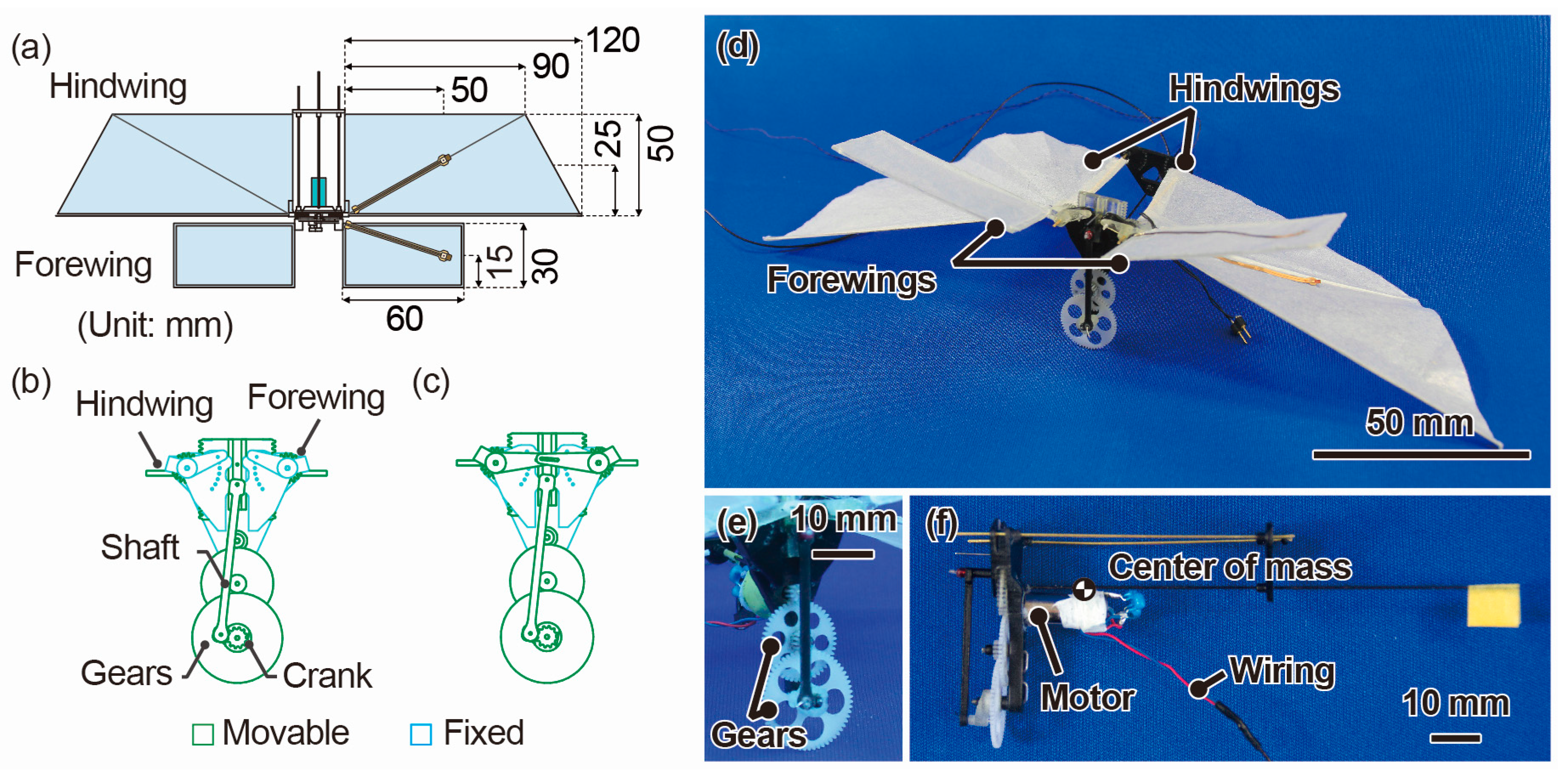
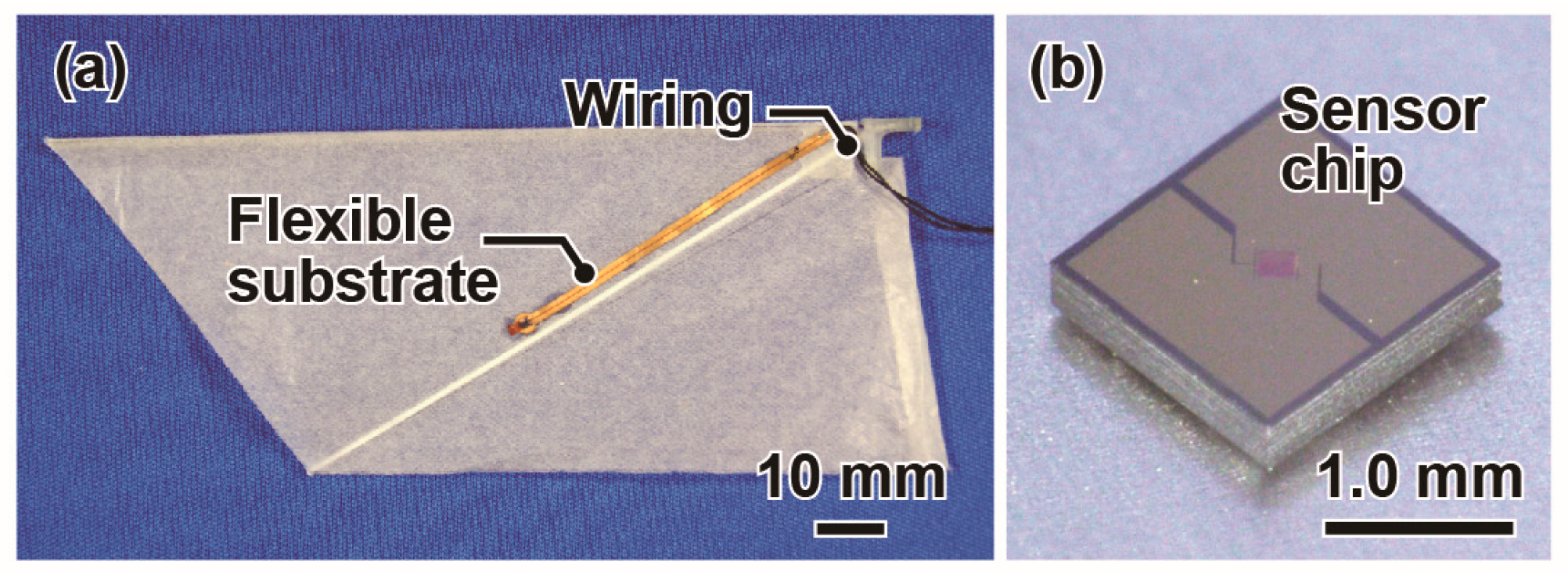


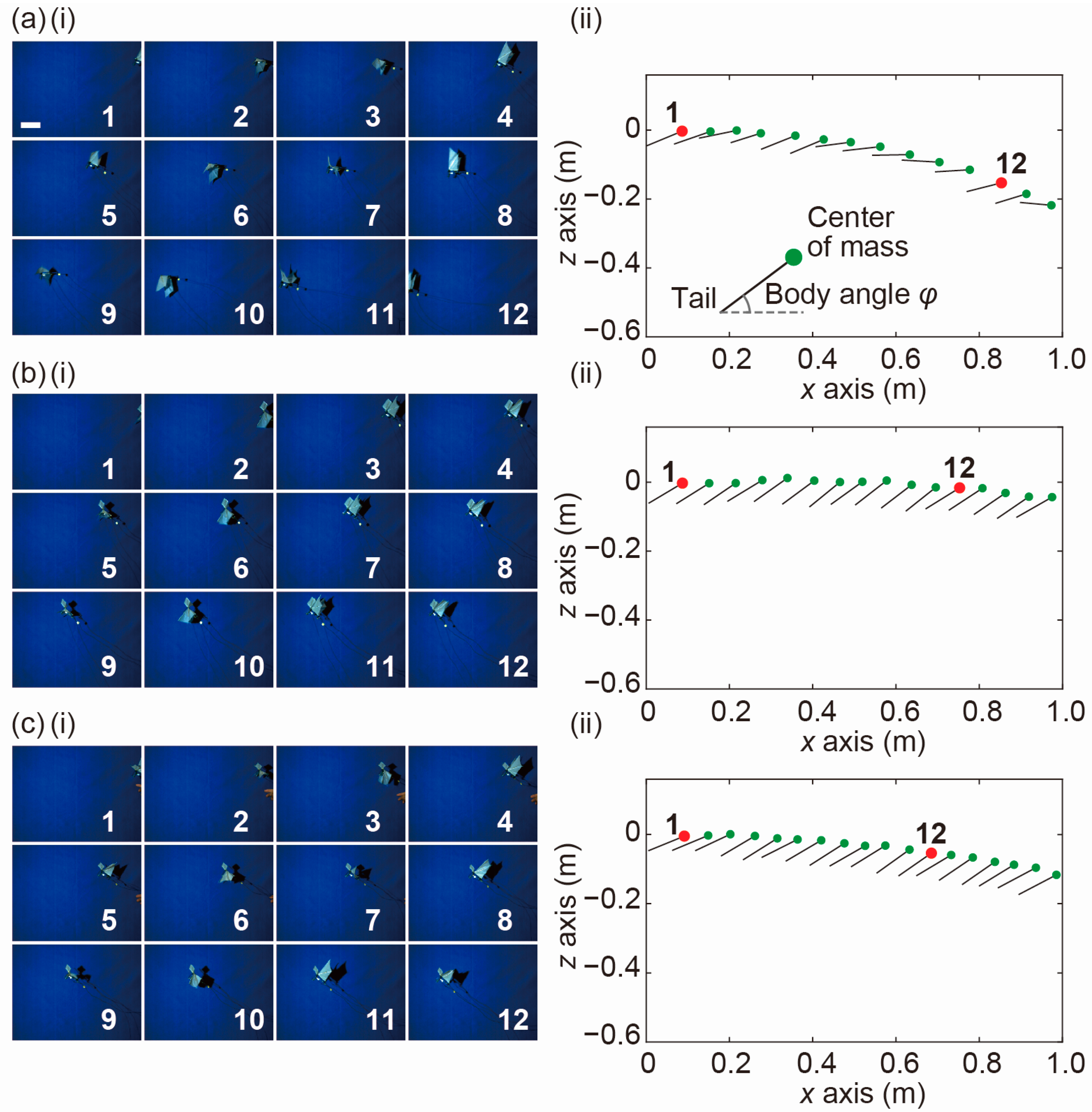
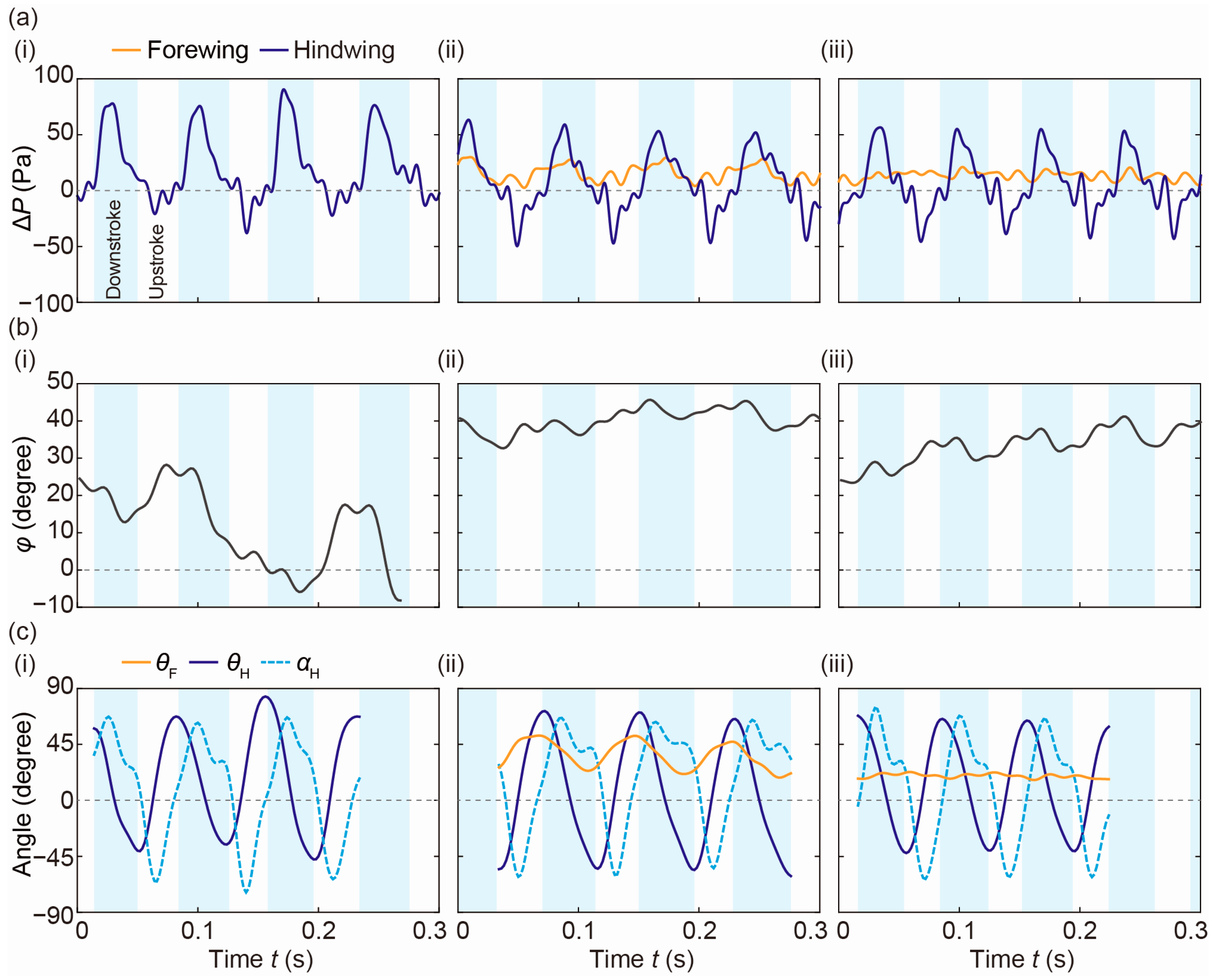
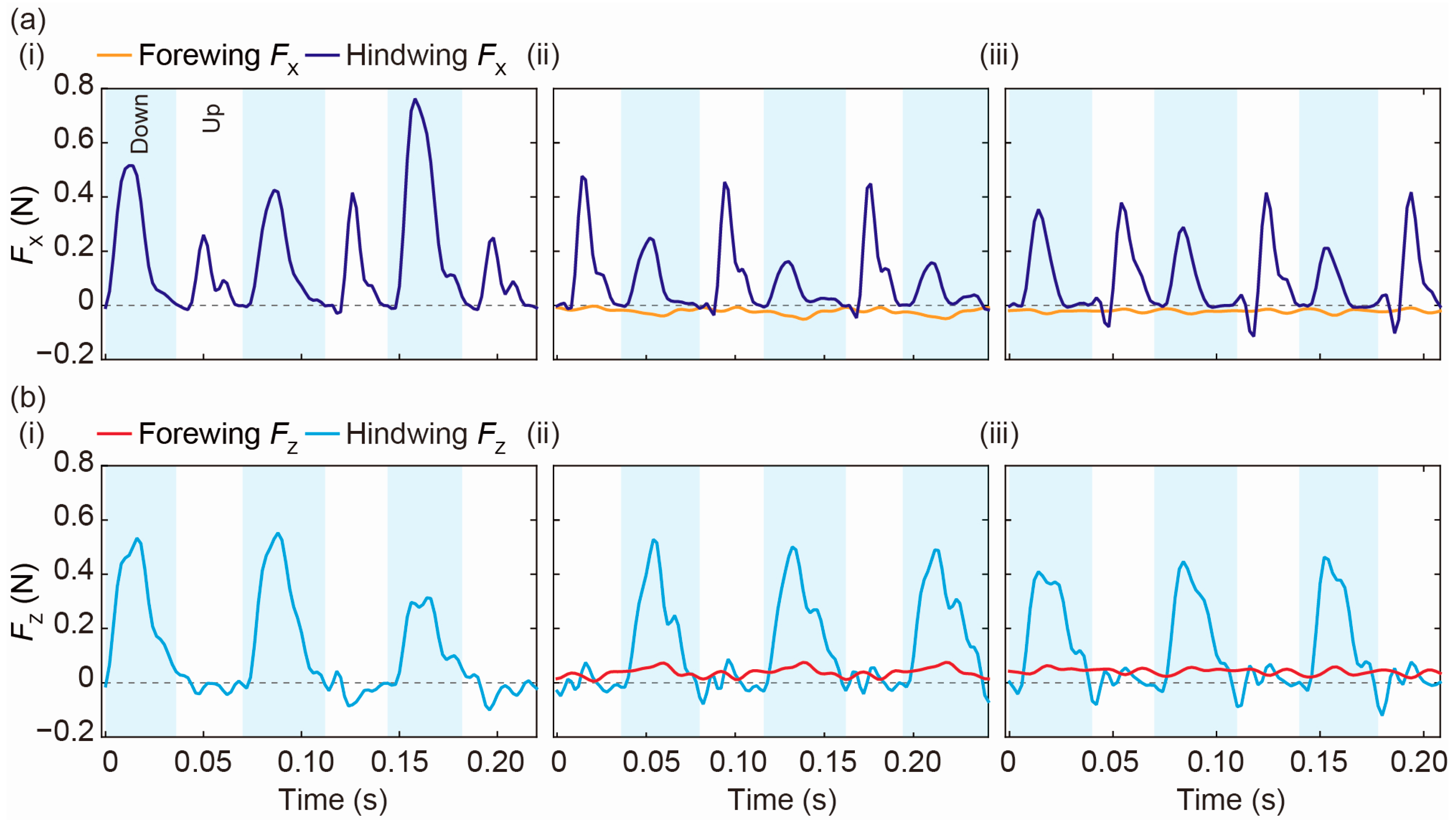
| Characteristics | Unit | Beetle [16,31,32] | Ornithopter with/without Forewing |
|---|---|---|---|
| Beetle species | Allomyrina dichotoma | ||
| Hindwing length, s | mm | 56 | 120 |
| Aspect ratio of forewing | ‒ | 2.1 | 2 |
| Aspect ratio of hindwing | ‒ | 2.8 | 2.4 |
| Mass | g | 6~10 | 13.9/12.5 |
| Flapping frequency, f | Hz | 35 | 14/13 |
| Amplitude θP-P of forewing | degree | +10~+50 | +10~+50 |
| Amplitude θP-P of hindwing | degree | −70~+86 | −70~+90 |
| Wing load | N/m2 | 50 (without forewing) | 10.0/12.3 |
| Reynolds number, Re | ‒ | 3.0 × 103 | 6.5 × 103 |
| Reduced frequency, k | ‒ | 0.13 | 0.15 |
| Ornithopter | Body frame | 6.28 |
| Forewings | 0.94 | |
| Hindwings | 0.57 | |
| Total | 7.79 | |
| Cables | Cables for motor supply | 3.60 |
| Cables for sensor signal | 2.51 | |
| Total | 6.11 |
| Characteristics | (i) | (ii) | (iii) |
|---|---|---|---|
| Forewing | none | flapping | fixed |
| θF (degree) | ‒ | +10~+50 | +14 |
| f (Hz) | 13 | 14 | 14 |
| Trial number | 7 | 8 | 7 |
| Average ΔP of forewing (Pa) | ‒ | 14.7 ± 1.9 | 12.0 ± 2.2 |
| Maximum ΔP of hindwing (Pa) | 72.8 ± 8.2 | 57.0 ± 4.6 | 51.1 ± 4.3 |
| Minimum ΔP of hindwing (Pa) | −46.4 ± 10.6 | −39.8 ± 5.0 | −41.0 ± 4.4 |
© 2018 by the authors. Licensee MDPI, Basel, Switzerland. This article is an open access article distributed under the terms and conditions of the Creative Commons Attribution (CC BY) license (http://creativecommons.org/licenses/by/4.0/).
Share and Cite
Takahashi, H.; Abe, K.; Takahata, T.; Shimoyama, I. Experimental Study of the Aerodynamic Interaction between the Forewing and Hindwing of a Beetle-Type Ornithopter. Aerospace 2018, 5, 83. https://doi.org/10.3390/aerospace5030083
Takahashi H, Abe K, Takahata T, Shimoyama I. Experimental Study of the Aerodynamic Interaction between the Forewing and Hindwing of a Beetle-Type Ornithopter. Aerospace. 2018; 5(3):83. https://doi.org/10.3390/aerospace5030083
Chicago/Turabian StyleTakahashi, Hidetoshi, Kosuke Abe, Tomoyuki Takahata, and Isao Shimoyama. 2018. "Experimental Study of the Aerodynamic Interaction between the Forewing and Hindwing of a Beetle-Type Ornithopter" Aerospace 5, no. 3: 83. https://doi.org/10.3390/aerospace5030083






